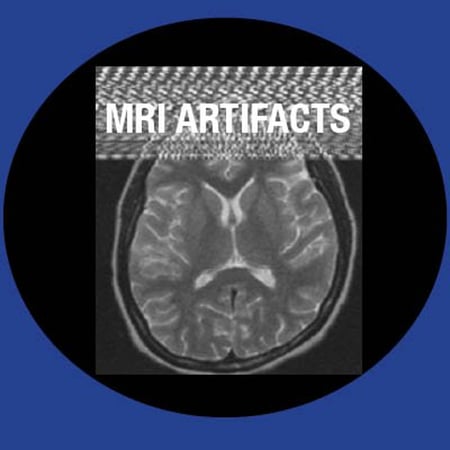Magnetic resonance imaging uses magnetic fields and radio waves to form images of the body. These images can be used to diagnose a wide variety of health conditions, making reading these images a critical  part of a radiologist’s training. Sometimes, structures appear in the MRI imaging that is not anatomically present. These artifacts can mimic pathologies, leading to improper diagnoses. Learning to recognized common artifacts and how to avoid them improves the diagnostic properties of MRI.
part of a radiologist’s training. Sometimes, structures appear in the MRI imaging that is not anatomically present. These artifacts can mimic pathologies, leading to improper diagnoses. Learning to recognized common artifacts and how to avoid them improves the diagnostic properties of MRI.
Artifacts can be categorized into three main types. Physiologic artifacts are caused by patient movement, including breathing, heartbeat, and blood flow. Artifacts can arise from the inherent physics of the MRI, such as the presence of metal or chemical shift. Finally, the hardware and software involved in constructing MRI images can cause artifacts.
Physiologic artifacts
Patient motion – intentional or not – cause artifacts on the MRI image. Motion artifacts typically show up as blurring or ghosting, especially in the phase-encoding direction. Recognizing that these ghost images are due to motion can help radiologists diagnose patients more accurately.
Because motion can make the images harder to read, patients should be advised to hold still during the exam. Make sure the patient is comfortable prior to beginning the sequence, and advise them when it is especially important remain still. You may need antispasmodic medications for some patients.
All patients will continue to breathe, have heartbeats, and blood flow during the exam. This periodic motion cannot be avoided, and can cause artifacts. Using faster sequences and respiratory-ordered phase encoding can help eliminate artifacts, as can navigator echo gating to track the motion of the diaphragm to time image acquisition.
Flow artifacts are also common, especially in gradient echo (GRE) sequences. Due to the nature of GRE sequences, blood flow will produce a bright signal. Using saturation bands can minimize this artifact, saturating the slice upstream so the blood will not produce a signal. Gradient moment nulling can also be applied to try to correct flow artifacts.
Inherent physical artifacts
Chemical-shift artifacts occur during the frequency encoding of the MRI process. Fat and water molecules oscillate differently within the magnetic field, causing them to show up differently during the encoding. This causes a black or bright band at the edge of the anatomy, and can sometimes be misinterpreted as pathology. Increasing the bandwidth, reducing the matrix size, or suppressing the fat-frequency signal can all minimize this artifact.
Magnetic susceptibility artifacts can occur when a patient has an implant or medical device in the MR room that responds to the magnetic field. These materials cause the image to have bright areas and dark areas near the magnetic object that are not anatomically correct. While this effect can be reduced by avoiding gradient echo sequences, occasionally this type of artifact can be useful in diagnosing patients, such as in the detection of hematomas. When used in certain circumstances these artifacts can enhance the image quality.
Hardware and software artifacts
Zipper artifacts can cause noise on the image, making it difficult to read. These occur when something in the environment interferes with the MRI unit, such as devices in the MR room, blinking light bulbs, the door not being securely shut, or nearby construction. Removing the source of interference should eliminate the artifact. MR rooms are typically isolated and strictly controlled to minimize the chance of interference.
While there are many types and causes of artifacts, being able to identify them and minimize their effects helps radiologists make proper diagnoses. Patient movement, the inherent aspects of MR imaging, and contamination are the most common sources of artifacts in MRI images.
Have MRI questions? Please contact Aston Diaz at 212-366-9100 x110 or astondiaz@atlantisworldwide.com
Some blogs you may have missed:
- Your MRI and Cryogen Venting
- 8 Channel MRI vs. 4 Channel MRI—What is the Difference?
- The Growing Need for MRI in Veterinary Medicine
- Before You Order That MRI: A Checklist
- Used CT & MRI Trade-ins: Get a Bang for Your Buck!
About the author: Aston Diaz




